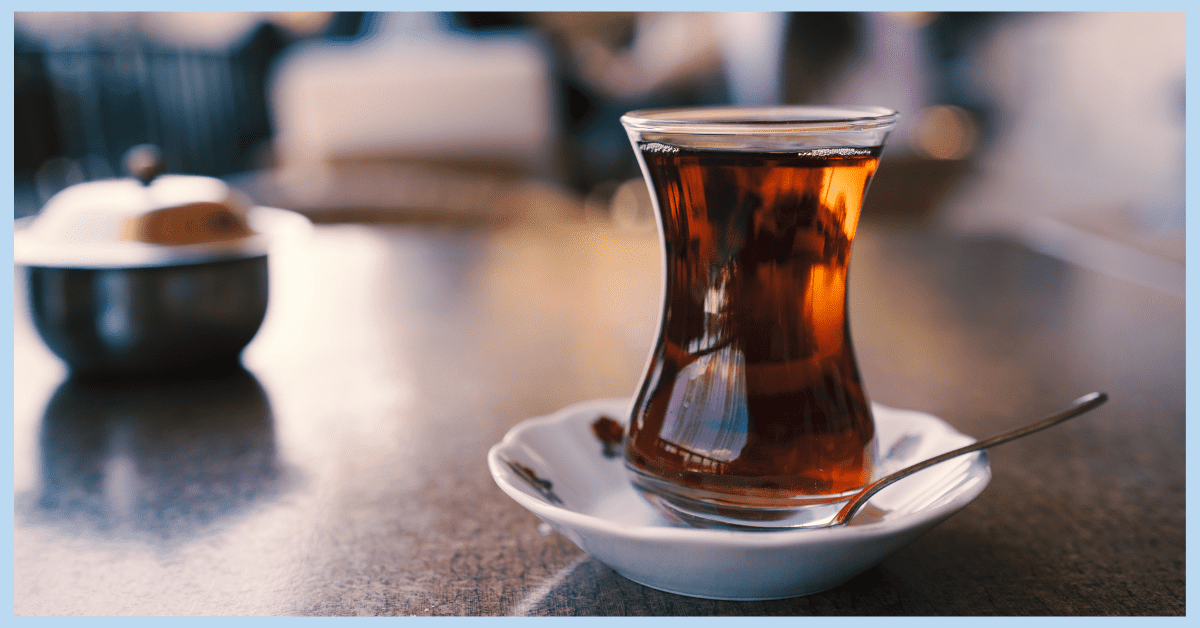No doubt Turkey is known for long-stretching lands featuring rich, historical landmarks. But did you know it’s equally famous for its flavor-packed tea, or çay (chai) in Turkish, and ranking as the top tea-consuming country? In every Turkish household, preparing and serving tea is a beloved tradition.
Inside Turkey, the tea industry is a US$5.72 billion industry in 2022. And the market is projected to grow annually by a whopping 10.44%. It’s become so popular that Turkey is now a huge exporter of tea, ranking fifth among the top exporting countries.
First, a Brief History of Turkish Tea
I couldn’t believe it – Turkish tea goes all the way back to the 5th century! It was considered a medicine and used along the Silk Road to trade for goods from China.
Only during the following century did Turkish tea start growing in popularity and people stopped associating it with medicine. Then in the 19th century, something major happened. Mehmet Izzet, the governor of Adana, Turkey at the time, piqued people’s interest in tea.
He distributed a tea pamphlet outlining some of the health benefits of drinking this satisfying reddish beverage. During this time, Turkish coffee dominated the hot beverage market, but it didn’t take long for Turkish people to open tea houses.
So, how did Turkish tea get even more popular? For that we’ll need to go back to the 1920s. It all began in 1922 when the Ottoman Empire completely dissolved and lost Mocha. For context, Mocha is a Yemeni city where the empire used to ship the majority of its coffee beans, which initially came from Ethiopia.
When coffee became way too expensive to import, Mustafa Kemal Pasha, the founder of the Republic of Turkey we know today, advocated drinking tea instead. And Turkish tea skyrocketed in popularity!
Currently, Turkey drinks the most tea in the world annually per person. About 6.96 lb (3.16 kg) of tea is drunk annually per person in Turkey. Fun fact: the second country to drink the most tea in a year is Ireland at 4.83 lb (2.19 kg) per person.
That’s not surprising given that tea is more than just a warm beverage in Turkish culture. It’s a welcoming gesture for guests, a chance for family time, and a drink that complements meals.
If you’ve ever been to Turkey, you’d understand why tea is the second most-consumed beverage after water. Everywhere you go, any time of day, you’ll be offered tea – in Turkey, it’s always tea-o’clock!
What Makes Turkish Tea Special (& Popular)
Turkish tea is a kind of black tea extracted from the Camellia Sinensis plant grown in the Rize province of Turkey. What adds to its uniqueness is the traditional Turkish method of preparing and presenting it.
I have to say – Turkish people have their own way of serving tea that makes you excited to experience it every time. But don’t worry, we’ll get to how Turkish tea is made in a minute!
Thanks to its unique preparation method, you can taste Turkish tea at various flavor intensities. There are three levels of concentration: light, middle, and dark (açik, orta karar, and koyu in Turkish).
Upon drinking it (with a little added sugar), you’ll detect a bitter taste that is quickly offset by a subtle hint of sweetness. A lot of people enjoy its bitter taste so much that they don’t sweeten it (including me!).
For your first time drinking it, I’d recommend adding a little bit of sugar so that it’s not so bitter. Then have a sugarless cup the second time around to see what it tastes like pure. After trying it in different ways, you can see which tastes you prefer. But if you try it for the very first time without any sugar, be prepared for a soothing, but bitter flavor.
Does Turkish Tea Have Caffeine, Sugar, Alcohol, or Calories?
Turkish tea contains about 62.2 mg of caffeine and 2 calories per cup. It doesn’t contain any alcohol or sugar. Let’s take a closer look at some of the nutritional facts and components of Turkish tea.
At cafés and restaurants in Turkey, it’s typically served with sugar cubes or packets on the side; the tea itself isn’t sweet. So the sugar content varies depending on whether you prefer to sweeten it or not.
An important thing to note: you may feel a little more alert after drinking çay because it contains caffeine. A group of researchers examined black tea, earl gray tea, and green tea – all of which were purchased from local Turkish markets.
The results revealed that all of them contained caffeine, with earl gray having the most and green tea having the least. The caffeine content of one cup of each Turkish tea type is as follows:
- Earl gray tea: 71.4 mg
- Black tea: 62.2 mg
- Green tea: 85.8 mg
Since the highest safe daily caffeine dose is 400 mg, you should be fine with a couple of cups of Turkish tea per day. If you LOVE Turkish tea and want to drink it as much as possible, you’d reach the 400 mg daily limit of caffeine in about 6 cups. Besides, it only has about 2 to 3 calories per 8 fl oz (8 fl oz is a little bit less than a Tall drink at Starbucks), so it won’t mess with your diet plan if you’re on one.
Why is Turkish Tea Red?
As mentioned before, Turkish tea is made from black tea leaves. These leaves are grown and gathered from the Camellia Sinensis plant, which initially grows green leaves.
To make black tea leaves, the green leaves wither after harvesting so they lose their water content. Finally, the leaves dry out and darken in color.
The oxidation process reduces the bitterness of the tea leaves and gives black tea its distinct flavor as well as its aroma.
Here’s an interesting fact: green tea and black tea are both derived from the same plant; the only difference is that green tea leaves are not oxidized! This explains why green tea has a yellowish hue and is more bitter than black tea.
Anyway, when tea leaves oxidize, they turn a dark brown, almost black color. When brewed, their tint turns the water red or mahogany in color.
Turkish Tea Health Benefits
Traditional Turkish tea has multiple health benefits. Keep in mind that too much of anything is bad. To put it another way, drinking more than four or five cups of çay per day may have negative effects on your health.
For instance, going over the recommended intake can cause headaches, irregular heartbeat, and can trigger anxiety. Whereas, if you stick to a safe consumption rate, you can enjoy some of its medicinal properties:
01. Reduces the Risk of Chronic Disease
Turkish tea is high in antioxidants, which are substances necessary for our bodies. We usually get them from foods like fruits, vegetables, and nuts, but black tea is another excellent source.
Antioxidants aid in the elimination of free radicals from our bodies. Simply put, free radicals are unstable atoms that cause illness and aging by damaging our cells. As a result, antioxidants help in reducing the risk of developing chronic or age-related diseases.
02. Improves Heart Health
An extensive study published in the scientific, peer-reviewed Heart journal looked at the heart health of people who drank tea daily and those who didn’t in the previous year.
Remarkably, the findings showed that daily tea drinkers had a 10% lower risk of serious cardiac events. What’s more, they were found to have an 8% lower risk of heart disease.
This can be attributed to the flavonoids, which are another type of antioxidant found in black tea and are fantastic at protecting our hearts.
03. Promotes Good Gut Bacteria
Black tea also contains polyphenols, which are compounds that improve our gut health. They simply stimulate the growth of good gut bacteria while inhibiting the growth of bad ones.
In case you didn’t know, gut bacteria play a critical role in our overall health. For example, certain types of gut bacteria can help reduce the risk of inflammatory bowel disease and type 2 diabetes.
Why is Turkish Tea Made in Two Pots?

Turkish tea is made in two pots because people loved the benefits of this method! Not only can its bitterness be 100% customized, but also if you run out of water in the bottom pot, you’ll be able to just boil some more and use the remaining tea concentration in the top pot.
This fun tea preparing method is where the magic happens!
The lower, larger pot is only used to boil water. And the upper, smaller pot is only for brewing a concentrated version of çay. When it’s time to serve, you just pour some concentrated çay from the smaller pot into a glass or cup and then dilute it with water from the larger pot.
I recommend starting out with a more diluted tea mixture so it’s not as bitter and then work your way up to the bitterness level you like. Be careful – it’ll be hot!
Try an authentic, delicious Turkish tea brand I personally recommend here (from Amazon).
How Do Turkish Teapots Work?
Turkish teapots, or çaydanlk in Turkish, are unique to brewing Turkish tea. To begin, there’s no lid on the lower pot where the water goes, but the upper pot does have a lid. The smaller pot’s base sits directly on top of the lower pot, entirely covering the opening.
Because they’re stacked on top of the stove, the steam emitted by the boiling water in the lower pot gets trapped. The upper pot continues to heat up from the steam to help in brewing the tea, and that’s all there is to it!
Why is Turkish Tea Served in Tulip-Shaped Glasses?
I doubt you’ve ever seen Turkish tea served in anything other than a tulip-shaped glass. It’s unknown exactly how the shape of the glass originated, but tulips were first brought to Turkey in the 16th century. The leader of the Ottoman Empire at the time, Sultan Suleyman the First, discovered tulips in Kazakhstan and fell in love with their beauty.
Since then, the shape of the tulip has been a consistent motif featured in authentic Turkish art, clothing, and carpets. Personally, I think it’s so cool how the impact of this history is actually visible in today’s tulip-shaped tea glasses.
If you go to drink a cup of tea from a tulip-shaped glass, I’d recommend holding it by the rim with your fingertips as the tea will be extremely hot and could be too hot to hold.
How to Make Turkish Tea Yourself (With Two Pots)
Preparing Turkish tea is one of the most satisfying processes, and the good news is that it’s not hard at all! Here are five steps to serve up traditional çay using the two teapot system:
Step 01: Boil Water
Fill the bottom pot with fresh, safe water so it’s about 70% full. After that, set it on the stove with the smaller pot positioned on top of it. Keep the teapots on the stove until the water begins to boil.
Step 02: Brew Tea Leaves
Once the water in the lower pot starts to boil, take the upper pot off. Next, add 1.5 tablespoons (to serve two people) of Turkish black tea leaves to the upper pot.
Get Turkish tea I stand behind here (from Amazon)!
Then, slowly pour some of the boiling water from the lower pot over the tea leaves. Fill the smaller pot with approximately 2.5 cups of boiling water.
Before placing the pots back on the stove, fill the bottom pot with more water to bring it back to its initial water level.
Step 03: Allow to Simmer
Reduce the heat after returning the Turkish teapots to the stove. Low heat allows the tea leaves to fully infuse their flavor into the water before boiling. Allow the tea leaves to brew for 10 to 15 minutes, and voilà your Turkish tea is ready to serve!
Pro tip: If you’re unsure whether the tea is ready or not, try looking at the leaves. If they’re sinking to the bottom, the tea is done; if not, leave it for a couple of more minutes.
Step 04: Serve & Enjoy!
As mentioned before, Turkish tea can be served in three different concentrations: light, middle, and dark.
If you prefer a more concentrated flavor, fill your cup or tulip-shaped glass halfway with the tea brew from the upper, smaller pot. If you prefer a light tea flavor, fill it to a quarter of the cup or glass. You can definitely try different concentrations to see what you enjoy the most.
Then, fill the rest of your cup or glass with hot water from the lower, larger pot. To top it off, add your desired sugar amount and enjoy the sensational taste and aroma! Drinking it without any sugar is also ok – it just depends on your preferences.
When to Drink Turkish Tea

A lot of Turkish people drink Turkish tea all throughout the day, including at or right after breakfast, lunch, and dinner. And it serves as a token of friendship and hospitality, so when visiting or having friends over, there’ll be plenty of tea rounds.
Interestingly, Turkish employers are required by law to allow at least two tea breaks per day to their employees! It’s so ingrained in the culture that it’s extremely accessible and affordable.
Similar to Spanish and Italian culture, Turkish people love to meet their friends to get tea and sit for hours chatting and sipping. I love that it brings people together and encourages conversation, community, and camaraderie. Such a simple thing helps make so many people happy!
Is Turkish Tea Safe During Pregnancy?
Yes, pregnant people can drink Turkish tea safely but only in moderation. Turkish tea contains caffeine, which should be limited during pregnancy. In addition to black tea, all teas derived from the Camellia Sinensis plant should be avoided as they also contain caffeine, including green tea, white tea, and oolong tea.
If a lot of caffeine reaches the fetus, its undeveloped liver has difficulty breaking down this stimulator. Not only that, but women who have consumed a lot of caffeine while pregnant are more likely to have serious problems giving birth.
They’re more likely to miscarry, have a baby with low birth weight, or have a baby with birth defects. So you know, the safe consumption amount of caffeine for pregnant people is about 300 mg per day.
However, a study found that some women who consumed less than 200 mg of caffeine daily had smaller babies at birth than those who didn’t. The problem is that low birth weight can indicate a higher risk of heart disease and obesity later in life.
In my humble opinion, drinking no more than one to two cups of Turkish tea a day would be ideal. However, now that you know the safe consumption limit, it’s totally up to you to make the decision.
Keep in mind that not all teas are considered safe to consume during pregnancy. Although some herbal teas, such as those made from spices or dried fruits, are caffeine-free, they can still be harmful to a fetus.
Not to get too graphic, they can cause abnormal menstrual bleeding, miscarriage, and many other complications. Don’t forget to read up on any beverage you intend to consume while pregnant!
Is Turkish Tea Good for Weight Loss?
It’s likely! Black tea tea is listed among tea varieties that can help with weight loss. Of course, green tea came in first on this list!
As noted earlier, black tea contains natural substances known as flavonoids. Regular consumption of flavonoid sources not only helps protect your heart but also helps lower your risk of obesity. Besides, Turkish tea contains specific compounds, such as thearubigins and theaflavins, that are super beneficial to the human body.
Science agrees. A 2014 University of Oslo study revealed some eye-opening results about drinking black tea and its connection to weight loss.
To put things in perspective, the study was initially designed to look at how black tea affected body composition and the risk of cardiovascular disease.
Participants continued to drink black tea for a period of time and significant results appeared after only three months. According to the findings, black tea can improve body weight and body fat distribution.
Takeaways
By now, I think it’s safe to say Turkish tea is steeped in history (sorry, dad joke). There are countless factors that make Turkish tea special. The most important qualities of Turkish tea are its huge cultural significance, authenticity, and how well it’s been preserved over centuries.
Every aspect of this beverage reflects Turkish culture, from the soil on which the tea leaves are grown to its unique method of preparation to its tulip-shaped glasses. It’s shown to have health benefits, pair nicely with a meal, and bring people together from all walks of life.
What is Turkish tea, then? For some, it’s just a kind of black tea. For others, it’s a gesture of care, bonding, and hospitality. It’s now up to you to give it a shot and decide for yourself!

